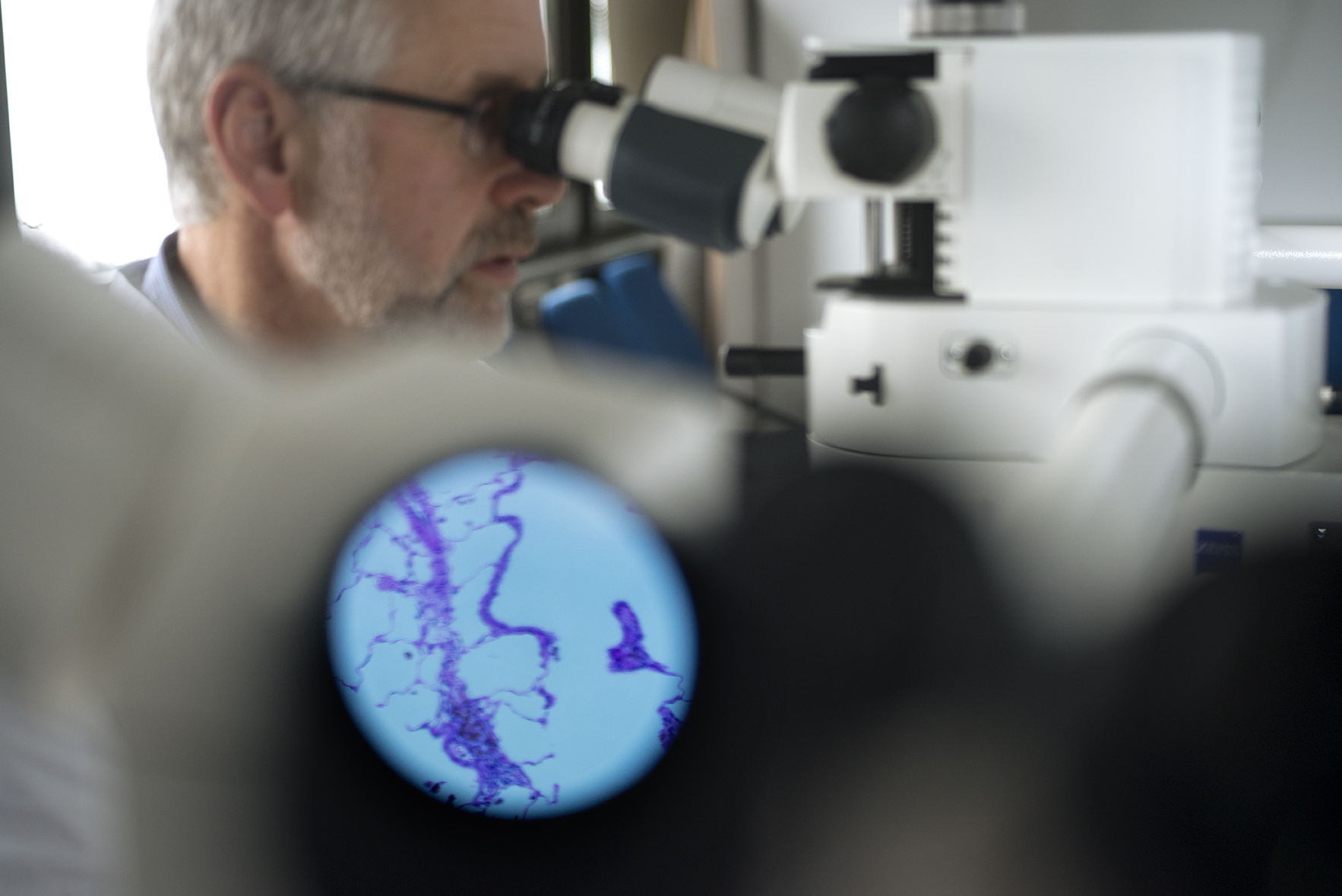Fraunhofer ITEM stands for toxicology testing and risk assessment of chemicals, active substances and drugs – with a focus on inhalation toxicology. Continued development of the corresponding exposure methods enables very small amounts of test substances to be used with high efficiency in toxicological studies.
Toxicology
Next generation risk assessment to set the stage for the future
Next Generation Risk Assessment
While conventional toxicology testing is still the required regulatory standard, our researchers are contributing to new assessment strategies through their own research projects based on the next generation risk assessment concept, aiming to provide predictive models for assessing the safety of compounds.
Based on the precision-cut lung slices (PCLS) technology that is well established at the institute, more human or humanized ex-vivo organ models, for example of the heart and liver, are in the process of further development. These models can also be used to test biopharmaceuticals and advanced therapy medicinal products (ATMPs). To analyze the results, the researchers combine the traditional endpoints among others with omics technologies, in particular metabolomics and functional genomics, and complex advanced bioinformatics analyses.
Assessment methods based on databases, such as the TTC (threshold of toxicological concern) concept, are being further developed, for example to identify non-genotoxic tumorigenic substances or to allow these methods to be used for the development of medical devices as well.
Publications
- Blümlein, K., Nowak, N., Ellinghusen, B., Gerling, S., Badorrek, P., Hansen, T., Hohlfeld, J. M., Paul, R., Schuchardt, S. (2023). Occupational exposure to veterinary antibiotics: Pharmacokinetics of enrofloxacin in humans after dermal, inhalation and oral uptake - A clinical study. Environmental Toxicology and Pharmacology 100: 104139. doi: 10.1016/j.etap.2023.104139 https://www.sciencedirect.com/science/article/abs/pii/S1382668923000819?via%3Dihub
- Bowden, A., Escher, S., Rose, J., Sadekar, N., Patlewicz, G., O'Keeffe, L., Bury, D., Hewitt, N. J., Giusti, A., Rothe, H. (2023). Workshop report: Challenges faced in developing inhalation thresholds of Toxicological Concern (TTC) - State of the science and next steps. Regulatory Toxicology and Pharmacology 142: 105434. doi: 10.1016/j.yrtph.2023.105434 https://www.sciencedirect.com/science/article/abs/pii/S0273230023001022 - Open Access
- Dekant, W., Antoniou, E. E., Bosch, A., Bruer, G. G., Colnot, T., Creutzenberg, O., Drexel, C. P., Duffin, R., Krueger, N., Nolde, J., Poland, C., Schaudien, D., Schuster, T. B., Stintz, M., Weber, K., Wessely, B., Zeegers, M. P. (2023). Issues in the inhalation toxicity testing and hazard assessment for low density particulate materials such as synthetic amorphous silica (SAS). Toxicology Letters [Epub ahead of print]. doi: 10.1016/j.toxlet.2023.02.002 https://www.sciencedirect.com/science/article/pii/S0378427423000905?via%3Dihub
- Drake, C., Wehr, M. M., Zobl, W., Koschmann, J., De Lucca, D., Kühne, B. A., Hansen, T., Knebel, J., Ritter, D., Boei, J., Vrieling, H., Bitsch, A., Escher, S. E. (2023). Substantiate a read-across hypothesis by using transcriptome data—A case study on volatile diketones. Frontiers in Toxicology 5: 14p. doi: 10.3389/ftox.2023.1155645 https://www.frontiersin.org/articles/10.3389/ftox.2023.1155645/full - Open Access
- Escher, S. E., Felter, S. P., Hollnagel, H., Boobis, A. R., Yang, C., Rathman, J., Cronin, M. T. D., Batke, M. (2023). Workshop report on the evaluation of the updated and expanded carcinogen database to support derivation of threshold of toxicological concern values for DNA-reactive carcinogens. Altex 40(2): 341-349. doi: 10.14573/altex.2210111 https://www.altex.org/index.php/altex/article/view/2556/2489 - Open Access
- Lange, F., Koch, W. (2023). Application of Resuspension Data of Respirable Particles for Early Phase Inhalation Following Deposition Contamination in Radiological Emergencies. Health Physics 124(3): 155-165. doi: 10.1097/HP.0000000000001648 https://journals.lww.com/health-physics/Fulltext/2023/03000/Application_of_Resuspension_Data_of_Respirable.1.aspx - Open Access
- Reamon-Buettner, S. M., Rittinghausen, S., Klauke, A., Hiemisch, A., Ziemann, C. (2024). Malignant peritoneal mesotheliomas of rats induced by multiwalled carbon nanotubes and amosite asbestos: transcriptome and epigenetic profiles Particle and Fibre Toxicology 21(1). doi: 10.1186/s12989-024-00565-x https://link.springer.com/article/10.1186/s12989-024-00565-x - Open Access
- Rodríguez, J. M. M., Frisk, A.-L., Kreutzer, R., Lemarchand, T., Lezmi, S., Saravanan, C., Stierstorfer, B., Thuilliez, C., Vezzali, E., Wieczorek, G., Yun, S.-W., Schaudien, D. (2023). European Society of Toxicologic Pathology (Pathology 2.0 Molecular Pathology Special Interest Group): Review of In Situ Hybridization Techniques for Drug Research and Development. Toxicologic Pathology [Epub ahead of print]. doi: 10.1177/019262332311782 https://journals.sagepub.com/doi/10.1177/01926233231178282 - Open Access
- Sanz, F., Pognan, F., Steger-Hartmann, T., Díaz, C., Asakura, S., Amberg, A., Bécourt-Lhote, N., Blomberg, N., Bosc, N., Briggs, K., Bringezu, F., Brulle-Wohlhueter, C., Brunak, S., Bueters, R., Callegaro, G., Capella-Gutierrez, S., Centeno, E., Corvi, J., Cronin, M. T. D., Drew, P., Duchateau-Nguyen, G., Ecker, G. F., Escher, S., Felix, E., Ferreiro, M., Frericks, M., Furlong, L. I., Geiger, R., George, C., Grandits, M., Ivanov-Draganov, D., Kilgour-Christie, J., Kiziloren, T., Kors, J. A., Koyama, N., Kreuchwig, A., Leach, A. R., Mayer, M.-A., Monecke, P., Muster, W., Nakazawa, C. M., Nicholson, G., Parry, R., Pastor, M., Piñero, J., Oberhauser, N., Ramírez-Anguita, J. M., Rodrigo, A., Smajic, A., Schaefer, M., Schieferdecker, S., Soininen, I., Terricabras, E., Trairatphisan, P., Turner, S. C., Valencia, A., van de Water, B., van der Lei, J. L., van Mulligen, E. M., Vock, E., Wilkinson, D. (2023). eTRANSAFE: data science to empower translational safety assessment. Nature Reviews Drug Discovery 22(8): 605-606. doi: 10.1038/d41573-023-00099-5 https://www.nature.com/articles/d41573-023-00099-5
- Schäferhenrich, A., Blümlein, K., Koch, W., Hahn, S., Schwarz, K., Poppek, U., Hebisch, R., Schlüter, U., Krug, M., Göen, T. (2023). Inhalation and dermal exposure to biocidal products during foam and spray applications. Ann Work Expo Health 67(7): 858-875. doi: 10.1093/annweh/wxad037 https://academic.oup.com/annweh/advance-article/doi/10.1093/annweh/wxad037/7221563 - Open Access
- Schwarz, K., Blumlein, K., Goen, T., Hahn, S., Hebisch, R., Koch, W., Poppek, U., Schaferhenrich, A., Schluter, U., Krug, M. (2023). Aerosol formation during foam application of non-volatile biocidal substances. Ann Work Expo Health 67(6): 731-743. doi: 10.1093/annweh/wxad031 https://academic.oup.com/annweh/article/67/6/731/7207786 - Open Access
- Warner, L., Bach-Hagemann, A., Schmidt, T. P., Pinkernell, S., Schubert, G. A., Clusmann, H., Albanna, W., Lindauer, U., Conzen-Dilger, C. (2023). Opening a window to the acutely injured brain: Simultaneous retinal and cerebral vascular monitoring in rats. Frontiers in Molecular Neuroscience 16: 1116841. doi: 10.3389/fnmol.2023.1116841 https://www.frontiersin.org/articles/10.3389/fnmol.2023.1116841/full - Open Access
 Fraunhofer Institute for Toxicology and Experimental Medicine
Fraunhofer Institute for Toxicology and Experimental Medicine